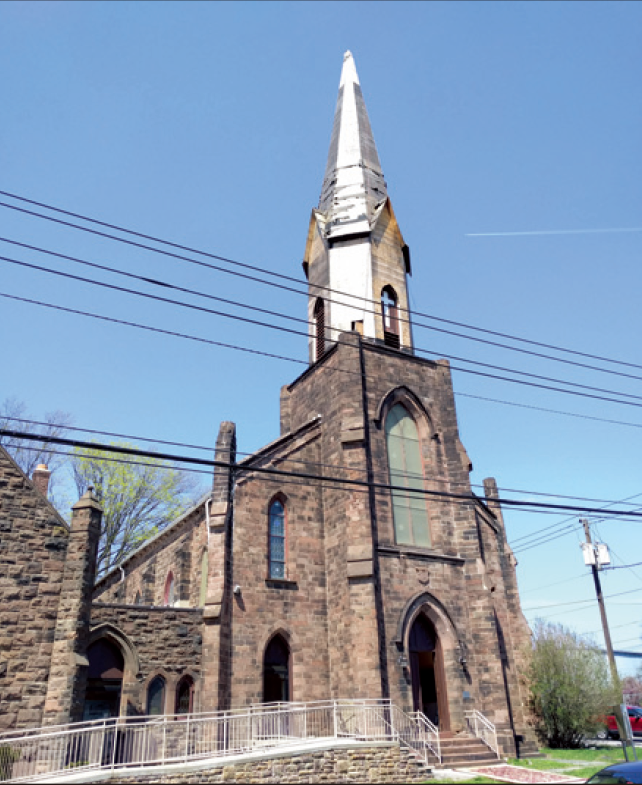Old church links Americans, Chinese in historical events
By William Hennelly in New York | China Daily Global | Updated: 2019-11-25 23:38

Soldiers in George Washington's Continental Army and Chinese immigrant railroad workers share a resting place on the grounds of an old church in New Jersey.
The former Dutch Reformed Church in Belleville, about 10 miles west of Manhattan, is believed to be the burial site of approximately 70 Continental Army soldiers. The church's steeple once served as a lookout for approaching British soldiers during the Revolutionary War.
On Nov 13, graduate students and professors in geophysics at Rutgers University-Newark began a search for remains of Chinese immigrants who worked on the Central Pacific Railroad, a section of the Transcontinental Railroad on which many Chinese toiled in the 1860s.
The Rutgers team used ground-penetrating radar to try to locate possible remains beneath the church.
"Partly archaeology, partly forensics, we do this when we get asked as kind of a community service project," Lee Slater, a geophysics professor at Rutgers, told CBS New York.
There is a stone marker on the church grounds in Chinese and in English that commemorates the workers on the 150th anniversary of the railroad's construction. There is also a red-brick monument with a white pagoda roof in a graveyard.
How did the workers, who ranged in age from teens to mid-30s, end up in Belleville?
After helping build the railroad, they headed east to work at the Passaic Steam Laundry and set up what is believed to the first Chinese workers community on the US East Coast, according to nj.com.
Around 70 Chinese workers arrived in 1870; they eventually reached a population of 250 and stayed in Belleville for about 15 years, nj.com reported.
The website said that in 1871, the workers celebrated Chinese New Year, which eventually became the largest such celebration on the East Coast, even attracting Chinese workers from New York.
Beth Lew-Williams, an assistant professor of history at Princeton University, told nj.com. "I was struck by the friendliness that came about in that community ... There were newspaper reports of white members of the community coming to the New Year's celebration."
"Belleville was a place that accepted these Chinese workers with open arms," Mayor Michael Melham told tapinto.com. "Belleville was the site of the first Chinatown on the East Coast. If there are workers in the ground under the church, we want to recognize their historical significance and give them a proper burial, if possible."
The church, which was founded in 1697, is listed on the US National Register of Historic Places. It was rebuilt in 1725, in 1807 and in 1853, the mayor told China Daily. He said he expects the results of the search to be available in about a month.
Human remains were first discovered in the church's basement by current Pastor Miguel Ortiz, who now leads the Pentecostal church called La Senda Antigua (Spanish for The Old Path).
"We were starting to clean up and we found a bone here and there," he told NBC New York.
The basement was supposed to be a temporary resting place for the remains of the workers, according to researchers. One objective is to send the remains back to China, which could be daunting because no records are available.
When the church was expanded in the 1800s, it was built over the cemetery.
"One of the documents that may come out of this would be a very precise map indicating the locations of these unmarked graves," Francisco Artigas, director of the Meadowlands Environmental Research Institute at Rutgers-Newark, told newjersey101.5com.
Michael Perrone, president of the Belleville Historical Society, told patch.com that "the 'basement' of the church is simply part of the original cemetery. The original church was a smaller structure. In order to enlarge the church, they built over part of the cemetery. The graves were not disturbed; they were simply built around and over everyone.
"The Dutch Reformed did not keep any death/burial records of anyone buried in the cemetery; that would have been a family matter. The church only kept baptism and marriage records since those are church sacraments," he said. "We have always known that there were individuals buried in what is now the 'basement' of the church, but what is simply a section of the original cemetery."
The mayor said "we really want to … acknowledge our past, never forget our past. We are very grateful that there are people here to bring awareness to this," said the mayor, adding that the Chinese settlement is part of the township's "amazing and diverse history".
























